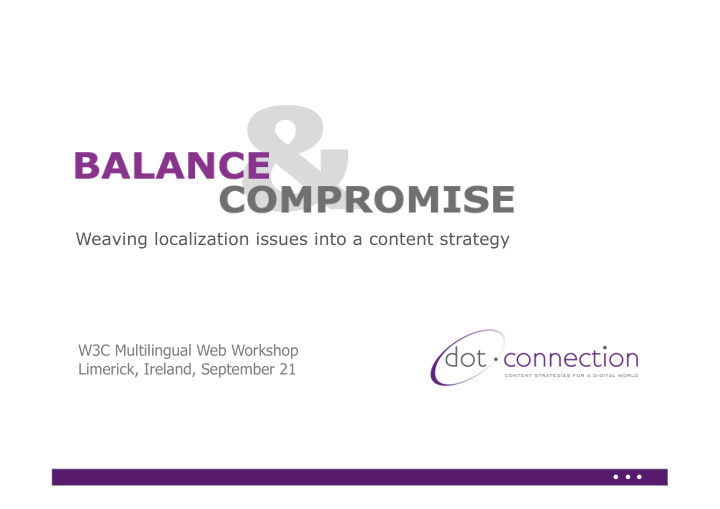



Weaving localization issues into a content strategy W3C Multilingual Web Workshop Limerick, Ireland, September 21
LOCALIZATION ON THE WEB: • Costly • Time-consuming • Quality an ongoing issue • Budgets are fragmented • Requires supporting tools and processes • Creates complexity
NO CONTENT STRATEGY Localization made more complex by lack thereof at the source • No governance Made more complex if • Seen as a cost you’re working without • ROI not measured a content strategy • Value not demonstrated
Content strategy plans for the creation, delivery, and governance of useful, usable content. Kristina Halvorson Author, Content Strategy for the Web and CEO, Brain Traffic
WHAT IS USEFUL, USABLE CONTENT? Content that is EFFECTIVE* • Appropriate • Useful • User-centered • Clear • Consistent • Concise • Supported *From Elements of Content Strategy, Erin Kissane, A Book Apart, 2011
HOW DOES USEFUL, USABLE CONTENT HAPPEN? Maintain and measure Review, refine, refresh • Archive Set objectives • Update • Goals • Test • Audiences • Measure • Purpose Carry out the plan • Production A sustainable strategy • Translation/localization Get a handle on what you have for your content • Indexing • Content • Publication • Costs • People, processes, workflow • Tools Develop a plan • Strategic plan (Who, what, where, when, how, and WHY) • Tactical planning (Editorial Identify pain points and low-hanging fruit calendar, Page specifications) • What can be optimized? • Where are the gaps?
How does useful, usable localized content happen? By weaving in localization issues into the content strategy process.
WHAT IS USEFUL, USABLE LOCALIZED CONTENT? Content that is EFFECTIVE PRINCIPLES OF EFFECTIVE CONTENT*…. … .APPLIED TO LOCALIZATION APPROPRIATE Applies to the local context USEFUL Addresses a market-specific purpose USER-CENTERED Users understand it easily CLEAR Translation quality is high; content is localized CONSISTENT Terminology and brand requirements upheld while costs kept down CONCISE Less is more – and less costs less SUPPORTED Processes, tools, people, and budgets in place *From Elements of Content Strategy, Erin Kissane, A Book Apart, 2011
SETTING THE TARGET Creating baselines and objectives • Market size and • Ability to speak potential English • Legal & contractual • Language preference obligations • Audience A, B, C, D • Brand recognition • Formal/informal • Competition • Internet penetration Market Cultural • Usage devices • Many other.. forces forces • Market presence Internal Site • Strategic • Inform Forces objectives considerations • Educate • #of people • Interact • Consistency of • Convert offering • Transact • Culture and heritage
ALLOWS FOR BASELINE TARGETS Defining what you SHOULD have • Number of languages • IA Model • Critical mass of localized content for each tier of site • Tiers should be in line with user expectations and ability to deliver
EXAMINING WHAT YOU HAVE Assessing your SOURCE content inventory • Volume of web pages • Volume of associated content assets • How often content changes • Relevance to local audiences • Potential for localization • Budget and ownership
EXAMINING WHAT YOU HAVE Governance model • Centralized or decentralized language management? • In-house or outsourced? • If outsourced, single frame agreement or several? • Centralized or decentralized web management? • Who owns the budget for what? Is there one?
EXAMINING WHAT YOU HAVE Tools, time, and metrics • What toolset is available for support? • Translation memories and Management? Terminology managers? Authoring tools? Integrated into CMS? • Latency Time from source to published, translated version • • Metrics If there are sites, are they being visited? • • Costs What’s it costing you today? •
SMARTER LOCALIZATION DECISIONS Doesn’t have to be all or nothing • Keep • Translate as is • Chunk • Add, subtract • Change • Shorten, Replace, Select, Rethink, Add • Leave it • Link to English • Provide no links
ENABLES BASELINE PLAN FOR LOCALIZATION How deep depends on your model Section Metad Navig Home About Produ Suppo Servic Resear Traini Events Add? / ata ation cts rt es ch ng Market Tier 1 Keep Keep Change Change Chunk Keep Keep Change Replace Replace Yes Tier 2 Keep Keep Change Change Chunk Change Leave Change Chunk Leave Yes Tier 3 Keep Keep Keep Change Chunk Change Leave Change Chunk Leave Yes Tier 4 Keep Keep Leave Change Leave Change Leave Change Leave Leave Yes Type of Action X volume X cost per language = Budgetary scope Also: Changes to CMS? Images? Investments in tools? Supplier relationships?
THE INVENTORY IN LOCAL If you’re not starting from scratch What’s on the website in local languages, • What’s been translated • What’s been localized • How it’s maintained • Owner • But also what’s out there • Enlist local help to locate • Mini-sites, YouTube, SlideShare, Twitter, Facebook • Then refine the baseline plan
GETTING TO SPECIFICS Weave localization into editorial page specifications • Editorial specs replace ‘lorem ipsum’ in wireframes with source content issues addressed: Objectives of page • Primary and secondary messages • Voice and tone • Calls to action • Related information • Images and call-outs • Terminology requirements •
LOCALIZATION IN THE PAGE SPEC Localization issues at tier and locale level • Issues to be addressed at tier level (if possible) Do you translate? Yes/No • Do you chunk, change or leave? • What’s global, what’s local • What’s distinct about the local • What changes and how? • • Issues to be addressed at locale level Keywords • Voice and tone • Source content for local differences • Who validates local content? • Who pays? •
GETTING IT DONE – AND KEEPING IT IN SYNCH • Don’t do it all at once! • It’s ongoing, not a project • Use tools speed up cycles and lower costs • Establish close relation with your LSP • Find alternatives to latency issues • Track metrics • Keep tabs on costs • Get a traffic manager! Photo credit: Fotolia
• Lise Janody • lise.janody@dot- connection.com • @lisejanody Photo credits: Fotolia
Recommend
More recommend